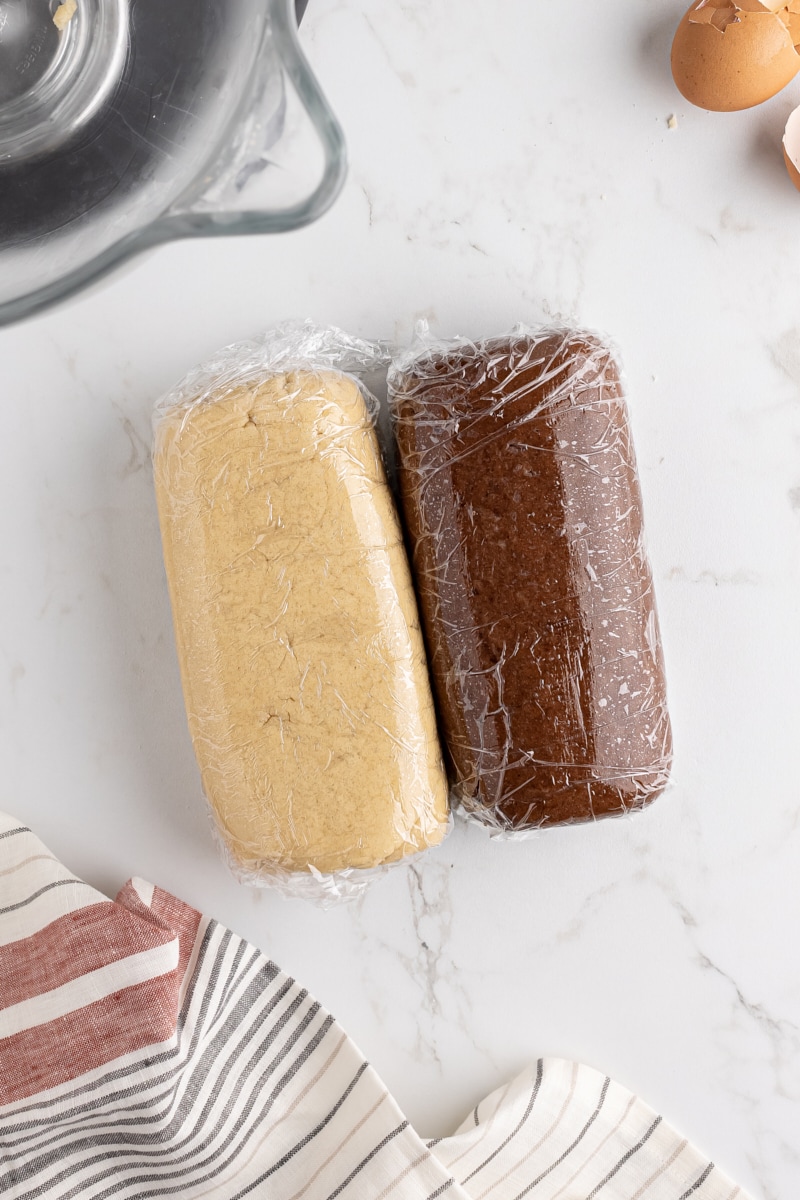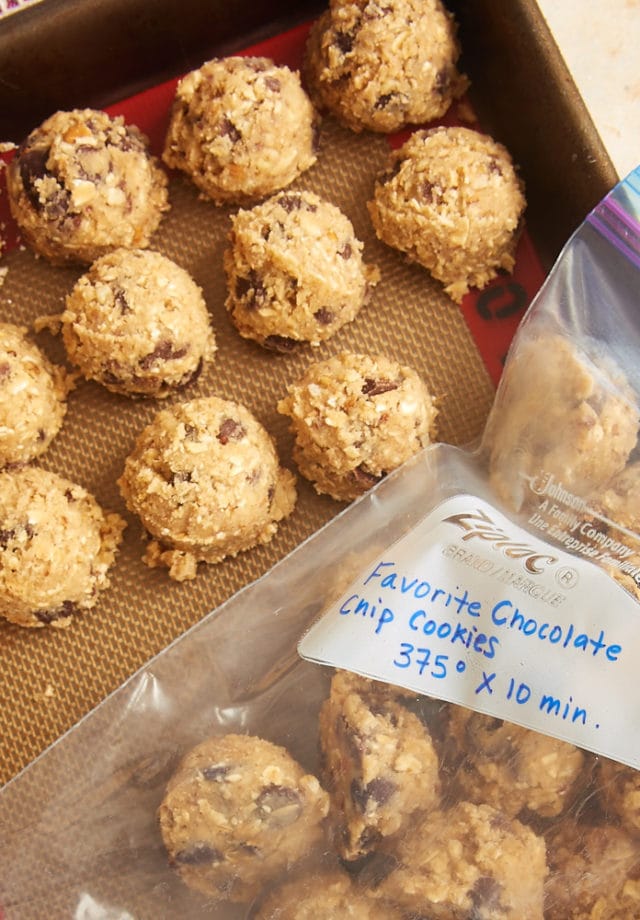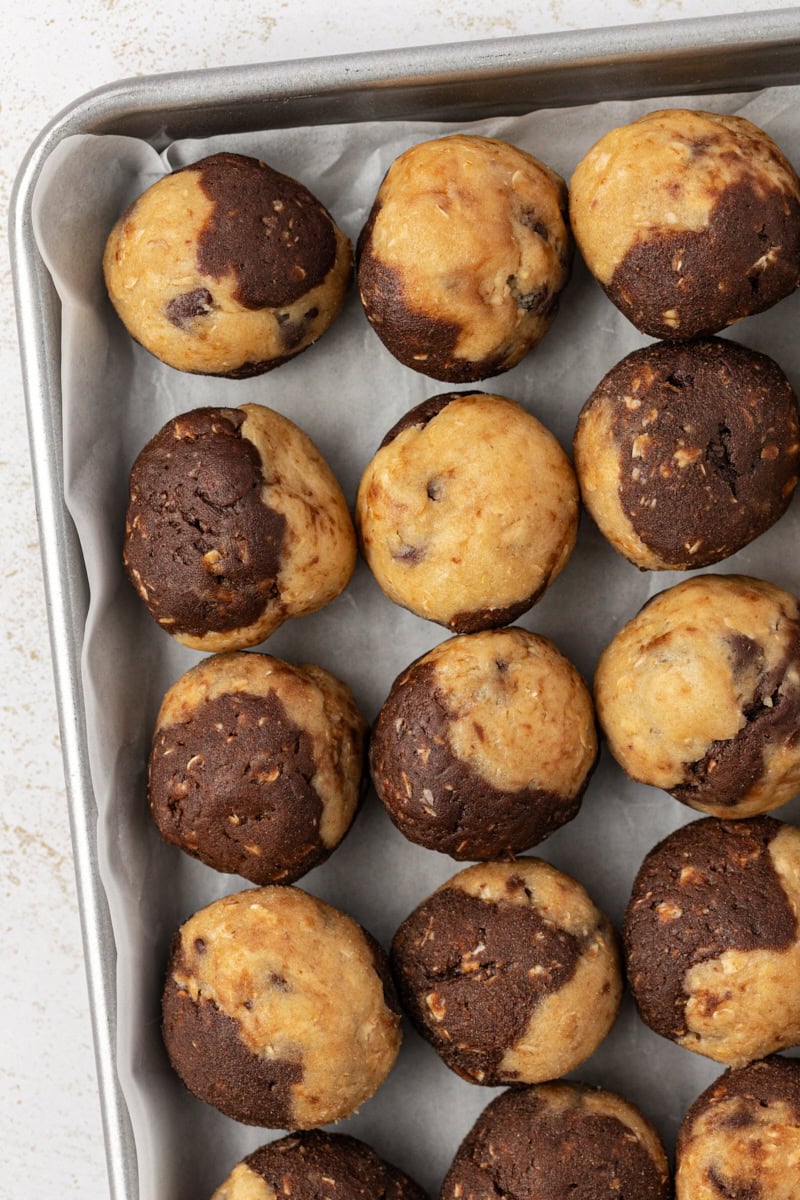Freezing cookie dough is the best way to have freshly baked cookies whenever you have a craving. Just follow these tips to keep your freezer stocked with plenty of cookie dough!

Cookies are one of my favorite things to bake, and there’s nothing better than enjoying them freshly baked. But did you know you can make that freshly baked goodness even more convenient? The secret is freezing cookie dough!
Here are some great reasons to freeze cookie dough:
- Freshly baked cookies anytime. Bake only what you need and enjoy warm cookies on demand.
- Save time during busy seasons. Perfect for holiday baking or preparing homemade gifts.
- Emergency desserts. Be ready for last-minute guests or cravings.
- Gift-ready convenience. Share frozen dough with friends so they can bake cookies whenever they like.
- Minimize waste. Freeze extra dough instead of baking more cookies than you need.
What types of cookie doughs freeze best?
Before we get too far, the first thing we should cover is what kinds of cookie doughs lend themselves well to freezing. The answer is that most cookie doughs, especially those with plenty of butter and fat, will freeze. Some just perform better than others. Most cookies can be categorized as drop cookies, slice-and-bake cookies, and cut-out cookies.
Drop Cookies
Drop cookies, which are those that are scooped and dropped onto a baking pan, are generally considered the best candidates for freezing. They’re likely the simplest overall from freezing to baking. We’re talking chocolate chip cookies, peanut butter cookies, and oatmeal cookies. (Possibly my most frequently frozen cookies are my favorite chocolate chip cookies, because the recipe makes a huge batch!)
Most cookies fall into the drop cookies category, so learning how to freeze that type of dough will easily keep your freezer stocked with plenty of dough just waiting to be turned into freshly baked cookies!
Slice and Bake Cookies
Slice-and-bake cookies are just as the name implies. The cookie dough is formed into a long log or other shape and sliced before baking.
Cut Out Cookies
Cut-out cookies involve rolling out cookie dough and cutting into shapes. That can be done with cookie cutters or just a knife.
So, let’s get down to dough freezing business! If you’re a cookie baker, you’ll likely already have all the things you need in your kitchen to get started.

How to Freeze Drop Cookie Dough
- Prepare the dough. Make your cookie dough as directed in the recipe up to the portioning stage. If your recipe requires chilling before scooping, follow those instructions.
- Prep the baking sheet. Line a baking sheet with parchment paper or a silicone liner. While optional, this prevents sticking and makes cleanup easier. Choose a pan size that fits your freezer and accommodates the amount of dough you’re freezing. A quarter sheet pan is often ideal for small freezers and can hold plenty of dough.
- Portion the dough. Use a cookie scoop for consistent sizing, and place dough balls on the baking sheet. If the recipe suggests flattening the dough, do that before freezing. Arrange the dough balls close together but not touching.
- Freeze until solid. Place the baking sheet flat in the freezer and freeze the dough until firm, typically 2-6 hours. Check after 2 hours but allow more time if needed to avoid freezer burn.
- Transfer to storage. Once frozen, transfer the dough balls to freezer bags or containers. They can be stored together without separation. Use a permanent marker to label the bag or container with the cookie name, freezing date, and baking instructions.
- Bake when ready. To bake, take the desired number of cookies directly from the freezer and place them on a lined baking sheet. No need to thaw! Bake as directed, adding 2-3 minutes to the baking time.

How to Freeze Slice-and-Bake Cookie Dough
- Prepare the dough. Make the cookie dough as directed. If the recipe requires chilling, follow those instructions.
- Freeze the dough logs. Shape the dough into logs and wrap them tightly in wax paper or plastic wrap. Place the wrapped logs into freezer bags. Adjust the log length if needed to fit your storage bags or containers.
- Alternative method: freeze pre-sliced dough. Follow the recipe through slicing the dough. Arrange the slices on a baking sheet in a single layer. Freeze until solid (2-6 hours). Then, transfer the frozen slices to a freezer-safe container, layering wax paper between the slices.
- Label and store. Label your freezer bags or containers with the cookie name, freezing date, and baking instructions.
- Baking slice-and-bake cookies. For dough logs, thaw at room temperature for 10-15 minutes or overnight in the refrigerator until firm but sliceable. For pre-sliced dough, bake directly from frozen on a lined baking sheet, adding 2-3 minutes to the baking time.
How to Freeze Cut-Out Cookie Dough
- Prepare the dough. Make the cookie dough as directed. If chilling is required, do so before freezing.
- Freeze the dough disc. Roll the dough into a disc about 1 inch thick. Wrap the disc well in plastic wrap and freeze.
- Alternative method: freeze pre-cut cookies. Roll out the dough and cut out the cookies as directed. Arrange the cut-outs on a baking sheet in a single layer. Freeze until solid (2-6 hours), then transfer the frozen cookies to a freezer-safe container, layering wax paper between them.
- Label and store. Label the bags or containers with the cookie name, freezing date, and baking instructions.
- Baking cut-out cookies. For frozen dough discs, thaw at room temperature for 10-15 minutes or overnight in the refrigerator. Roll out the dough and cut the cookies as directed. For pre-cut cookies, bake directly from frozen, adding 2-3 minutes to the baking time.

Do I Thaw Cookie Dough Before Baking?
You don’t necessarily need to thaw cookie dough before baking it. I almost always bake the cookies straight from the freezer.
As you might guess, baking cookie dough straight from the freezer usually takes a big longer. As a general rule, they’ll need 2 or 3 extra minutes in the oven.
Alternatively, you can thaw the cookies on your countertop for about 15 minutes or in your refrigerator overnight. If you go one of those latter routes, the cookies shouldn’t need any extra baking time.
When Do I Do Extra Steps, Like Rolling in Sugar?
If your cookie recipe calls for any kind of extra treatment before baking, then that needs to be done when you’re ready to bake them. That means a sprinkling of salt, or even a roll in sugar like crinkle cookies or cinnamon-sugar like snickerdoodles.
For those types of cookies, I recommend letting them thaw for 10 or 15 minutes before adding that sprinkling of salt or rolling the dough in sugar. Those few minutes of thawing will help the salt or sugar stick to the dough better. Keep in mind that thawed cookie dough likely won’t need the extra baking time that frozen dough requires.
Can I Freeze Thumbprint Cookies?
Absolutely! Thumbprint cookies will either have their indentions made before or after baking. If that occurs before baking, you can do that before they’re frozen so that they’re ready to go when you’re ready to bake them.
Many of these types of cookies are filled after they’re baked, so you can add that step after baking. If your thumbprint cookies should happen to bake the filling along with the cookies, that filling will likely need to skip the freezer and be made when you’re ready to bake for the best results.

What Kinds of Cookie Dough Don’t Freeze Well?
It’s also important to know what kinds of cookie doughs aren’t good candidates for freezing. As a general rule, delicate and cake-like cookie doughs, such as madeleines and whoopie pies, generally don’t freeze well in their unbaked form. Cookie doughs that are more batter than dough don’t do well, either. Macaroons are a good example of that type of dough.
How Long Does Frozen Cookie Dough Last?
As a general guideline, most cookie doughs will last up to 3 months in the freezer when stored properly. If the recipe you’re using states otherwise, then follow their guidelines. Don’t forget to write the date the dough was made on your freezer bags! I also like to include the baking directions on the bag or in the container to make baking them as simple as possible when it’s cookie time.
With a freezer stocked with cookie dough, you can have freshly baked cookies whenever the craving strikes. Keep a few different kinds in there and make a little cookie buffet! You’ll certainly thank your past self for their efforts.
Bake or Break is a participant in the Amazon Services LLC Associates Program, an affiliate advertising program designed to provide a means for us to earn fees by linking to Amazon.com and affiliated sites.








One Comment on “How to Freeze Cookie Dough”
Perfect little treats for this time of year!